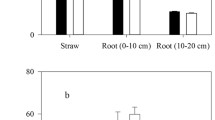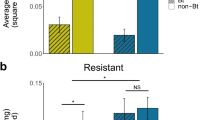Abstract
Genetically engineered corn (Zea mays L.) containing a gene from the soil bacterium Bt (Bacillus thuringiensis) constitutes a large proportion of all corn planted in the United States. In a number of studies, Bt plant residues have been reported to have higher lignin content and to decompose slower than those of non-Bt plants, possibly due to the presence of the Cry endotoxin. We hypothesize that after multiple years of continuous cultivation of Bt corn, the combined results of alleged differences in Bt corn residues and of Cry endotoxin presence will be reflected in soil characteristics, specifically in an increase in soil total carbon (C) and nitrogen (N) levels. We collected soil samples at 0–7.5 cm depth in 2006 from continuous Bt and non-Bt corn treatments in an randomized complete block design experiment with four replications. The experiment was established in 1999 at the Kellogg Biological Station long-term ecological research (LTER) site in southwest Michigan. We found that, after 7 years of Bt cropping, neither total soil C and N nor soil C mineralized during a 35-day incubation were significantly different between Bt and non-Bt corn treatments (P > 0.05). Total soil C was equal to 7.3 g kg−1 and 7.4 g kg−1, in Bt and non-Bt corn, respectively, with a standard error of the means (SEM) = 0.2, and total N was 0.67 g kg−1 (SEM 0.02) in both treatments. Post-hoc power analysis indicated that, given the number of samples collected in this study and the observed level of variability, the minimal differences between the Bt and non-Bt treatments that could be detected as statistically significant at α = 0.05 with a power of 0.80 were equal to 1.0 g kg−1, 0.14 g kg−1 and 0.125 g kg−1 for total C, total N, and soil C mineralized during a 35-day incubation, respectively. The results indicate that continuous Bt corn production during a 7-year period did not lead to sizeable changes in total soil C and N.

Similar content being viewed by others
References
Blackwood CB, Buyer JS (2004) Soil microbial communities associated with Bt and non-Bt corn in three soils. J Environ Qual 33:832–836
Castaldini M, Turrini A, Sbrana C, Benedetti A, Marchionni M, Mocali S, Fabiani A, Landi A, Santomassimo F, Pietrangeli B, Nuti MP, Miclaus N, Giovannetti M (2005) Impact of Bt corn on rhizospheric and soil eubacterial communities and on beneficial mycorrhizal symbiosis in experimental microcosms. Appl Environ Microbiol 71:6719–6729. doi:10.1128/AEM.71.11.6719-6729.2005
Coleman D, Hunter M, Hendrix P, Crossley D, Simmons B, Wickings K (2006) Long-term consequences of biochemical and biogeochemical changes in the Horseshoe Bend agroecosystem, Athens, GA. Eur J Soil Biol 42:S79–S84. doi:10.1016/j.ejsobi.2006.07.019
Collins HP, Elliott ET, Paustian K, Bundy LC, Dick WA, Huggins DR, Smucker AJM, Paul EA (2000) Soil carbon pools and fluxes in long-term corn belt agroecosystems. Soil Biol Biochem 32:157–168. doi:10.1016/S0038-0717(99)00136-4
Cortet J, Andersen MN, Caul S, Griffiths B, Joffre R, Lacroix B, Sausse C, Thompson J, Krogh PH (2006) Decomposition processes under Bt (Bacillus thuringiensis) maize: results of a multi-site experiment. Soil Biol Biochem 38:195–199. doi:10.1016/j.soilbio.2005.04.025
Devare M, Londono R L, Thies J (2007) Neither transgenic Bt maize (MON863) nor tefluthrin insecticide adversely affect soil microbial activity or biomass: a 3-year field analysis. Soil Biol Biochem 39:2038–2047. doi:10.1016/j.soilbio.2007.03.004
Donegan KK, Palm CJ, Fieland VJ, Porteous LA, Ganio LM, Schaller DL, Bucao LQ, Seidler RJ (1995) Changes in levels, species, and DNA fingerprints of soil microorganisms associated with cotton expressing Bacillus thuringiensis var. kurstaki endotoxin. Appl Soil Ecol 2:111–124. doi:10.1016/0929-1393(94)00043-7
Fang M, Motavalli P, Kremer R, Nelson K (2007) Assessing changes in soil microbial communities and carbon mineralization in Bt and non-Bt corn residue-amended soils. Appl Soil Ecol 37:150–160. doi:10.1016/j.apsoil.2007.06.001
Flores S, Saxena D, Stotzky G (2005) Transgenic Bt plants decompose less in soil than non-Bt plants. Soil Biol Biochem 37:1073–1082. doi:10.1016/j.soilbio.2004.11.006
Gee GW, Bauder JW (1986) Particle-size analysis. In: Klute A (ed) Methods of soil analysis: part 1. Physical and mineralogical methods. American Society of Agronomists, Madison, WI, pp 383–412
Griffiths BS, Caul C, Thompson J, Birch ANE, Scrimgeour C, Andersen MN, Cortet J, Messean A, Sausse C, Lacroix B, Krogh PH (2005) A comparison of soil microbial community structure, protozoa and nematodes in field plots of conventional and genetically modified maize expressing the Bacillus thuringiensis CryIAb toxin. Plant Soil 275:135–146. doi:10.1007/s11104-005-1093-2
Hao X, Kravchenko AN (2007) Management practice effects on surface total carbon: differences along a textural gradient. Agron J 99:18–26
Hopkins DW, Gregorich EG (2003) Detection and decay of the Bt endotoxin in soil from a field trial with genetically modified maize. Eur J Soil Sci 54:793–800. doi:10.1046/j.1351-0754.2003.0563.x
Icoz I, Stotzky G (2008) Fate and effects of insect-resistant Bt crops in soil ecosystems. Soil Biol Biochem 40:559–586. doi:10.1016/j.soilbio.2007.11.002
Icoz I, Saxena D, Andow D, Zwahlen C, Stotzky G (2008) Microbial populations and enzyme activities in soil in situ under transgenic corn expressing cry proteins from Bacillus thuringiensis. J Environ Qual 37:647–662. doi:10.2134/jeq2007.0352
Jung HG, Sheaffer CC (2004) Influence of Bt transgenes on cell wall lignification and digestibility of maize stover for silage. Crop Sci 44:1781–1789
Kellogg Biological Station (2007) LTER. [online]. Available at http://houghton.kbs.msu.edu/data/agronomic_protocol/2007AgronomicProtocol.pdf / (verified 20 Aug. 2007). KBS, Hickory Corners, MI
Klute A (1986) Water retention: laboratory methods. In: Klute A (ed) Methods of soil analysis: part 1. Physical and mineralogical methods. American Society of Agronomists, Madison, WI, pp 383–412
Lehman RM, Shannon LO, Rosentrater KA (2008) No differences in decomposition rates observed between Bacillus thuringiensis and non-Bacillus thuringiensis corn residue incubated in the field. Agron J 100:163–168. doi:10.2134/agrojnl2007.0123
Marvier M, McCreedy C, Regetz J, Kareiva P (2007) A meta-analysis of effects of Bt cotton and maize on nontarget invertebrates. Science 316:1475–1477. doi:10.1126/science.1139208
Mungai NW, Motavalli PP, Nelson KA, Kremer RJ (2005) Differences in yields, residue composition and N mineralization dynamics of Bt and non-Bt maize. Nutr Cycl Agroecosyst 73:101–109. doi:10.1007/s10705-005-8850-8
North Central Regional Research Publication No 221. (1998) Recommended chemical soil test procedures for the North Central Region. Published by the University of Missouri Extension. Columbia, MO
Paul EA, Harris D, Collins HP, Schulthess U, Robertson GP (1999) Evolution of CO2 and soil carbon dynamics in biologically managed, row-crop agroecosystems. Appl Soil Ecol 11:53–65. doi:10.1016/S0929-1393(98)00130-9
Poerschmann J, Gathmann A, Augustin J, Langer U, Gorecki T (2005) Molecular composition of leaves and stems of genetically modified bt and near-isogenic non-bt maize-characterization of lignin patterns. J Environ Qual 34:1508–1518. doi:10.2134/jeq2005.0070
Robertson GP, Wedin D, Groffman PM, Blair JM, Holland EA, Nadelhoffer KJ, Harris D (1999) Soil carbon and nitrogen availability: nitrogen mineralization, nitrification, and soil respiration potentials. In: Robertson GP, Coleman DC, Bledsoe CS, Sollins P (eds) Standard soil methods for long-term ecological research. Oxford University Press, NY, pp 258–271
SAS (2002) SAS user’s guide. Version 8.2. SAS Institute, Cary, NC
Saxena D, Stotzky G (2001) Bt corn has a higher lignin content than non-Bt corn. Am J Bot 88:1704–1706. doi:10.2307/3558416
Saxena D, Flores S, Stotzky G (2002) Bt toxin is released in root exudates from 12 transgenic corn hybrids representing three transformation events. Soil Biol Biochem 34:133–137. doi:10.1016/S0038-0717(01)00161-4
Shen RF, Cai H, Gong WH (2006) Transgenic Bt cotton has no apparent effect on enzymatic activities or functional diversity of microbial communities in rhizosphere soil. Plant Soil 285:149–159. doi:10.1007/s11104-006-9000-z
Six J, Paustian K, Elliott ET, Combrink C (2000) Soil structure and organic matter: I. Distribution of aggregate-size classes and aggregate-associated carbon. Soil Sci Soc Am J 64:681–689
Stroup WW (2002) Power analysis based on spatial effects mixed models-a tool for comparing design and analysis strategies in the presence of spatial variability. J Agric Biol Environ Stat 7:491–511. doi:10.1198/108571102780
USDA Economic Research Service (2008) Adoption of genetically engineered crops in the US: extent of adoption. http://www.ers.usda.gov/Data/biotechcrops/adoption.htm
Zwahlen C, Hilbeck A, Nentwig W (2007) Field decomposition of transgenic Bt maize residue and the impact on non-target soil invertebrates. Plant Soil 300:245–257. doi:10.1007/s11104-007-9410-6
Author information
Authors and Affiliations
Corresponding author
Additional information
Responsible Editor: Elizabeth (Liz) A. Stockdale.
Rights and permissions
About this article
Cite this article
Kravchenko, A.N., Hao, X. & Robertson, G.P. Seven years of continuously planted Bt corn did not affect mineralizable and total soil C and total N in surface soil. Plant Soil 318, 269–274 (2009). https://doi.org/10.1007/s11104-008-9836-5
Received:
Accepted:
Published:
Issue Date:
DOI: https://doi.org/10.1007/s11104-008-9836-5




